Study on Carbon Emission Measurement in Building Materialization Stage
Abstract
1. Introduction
2. Carbon Emission Accounting System in Building Materialization Stage
2.1. Carbon Emission Accounting Basis
2.1.1. Accounting Method
2.1.2. Determination of Carbon Emission Factors
2.2. Construction of Carbon Emission Accounting Model
2.2.1. Building Material Production Stage
2.2.2. Building Construction Stage
2.2.3. Building Material Transportation Stage
2.3. Data Sources and Function Units
3. Case Study
3.1. Carbon Emission Patterns in the Residential Building Materialization Stage
3.1.1. Basic Information of Residential Buildings
3.1.2. Measurement and Analysis of Carbon Emission
3.1.3. Construction Indicators and Carbon Emissions
Number of Building Layers and Carbon Concentration
Building Area and Carbon Emission
Carbon Concentration in Building Material Production Stage
4. Discussion
4.1. Major Influencing Factors
4.2. Carbon Reduction Strategy and Sensitivity Analysis
4.2.1. Sensitivity Analysis Method
4.2.2. Sensitivity Analysis at Different Stages
4.2.3. Carbon Reduction Strategy and Strategy Sensitivity
Material Production Stage
Construction Stage
Material Transportation Stage
4.2.4. Summary of Carbon Reduction Strategy
5. Conclusions
- (1)
- The range of carbon concentration during the materialization stage of the 15 residential buildings is between 372.43 kgCO2/m2 and 525.88 kgCO2/m2, with an average concentration of 442.91 kgCO2/m2. The relationship between the building layer and carbon concentration during the materialization stage is weak, and the degree of dispersion is large. The area of a building is linearly related to the carbon emissions during the materialization stage, and the expression for this relationship is the carbon emissions = 0.474 × building area—1220.971. The carbon concentration during the production stage of building materials accounts for 94.27% of the total carbon concentration, with the highest carbon concentrations found in steel bars and concrete, which account for 42.48% and 32.86% of the total carbon concentration of building materials, respectively;
- (2)
- The sensitivity coefficients of carbon reduction strategies for different stages differ significantly. The sensitivity coefficients for carbon reduction strategies during the production stage of building materials are all greater than 10%, while those for carbon reduction strategies during the construction stage of buildings are greater than 1%, and those for carbon reduction strategies during the transportation stage of building materials are less than 1%;
- (3)
- The stage of building residential buildings with the highest sensitivity to carbon reduction strategies is the production of building materials, followed by the construction stage, while the transportation stage has the lowest sensitivity. In order to effectively reduce the carbon emissions of residential buildings throughout the materialization stage, it is necessary to focus on carbon reduction strategies such as improving the recycling rate of building materials, using green building materials, using high-performance building materials, and increasing green areas. The absolute position of the carbon emissions of building materials in the materialization stage suggests that potential carbon reduction measures are likely to be related to materials, which is consistent with the current popular research direction.
Author Contributions
Funding
Institutional Review Board Statement
Informed Consent Statement
Data Availability Statement
Conflicts of Interest
References
- Zhang, Y.; Jiang, X.; Cui, C.; Skitmore, M. BIM-Based Approach for the Integrated Assessment of Life Cycle Carbon Emission Intensity and Life Cycle Costs. Build. Environ. 2022, 226, 109691. [Google Scholar] [CrossRef]
- You, K.; Ren, H.; Cai, W.; Huang, R.; Li, Y. Modeling Carbon Emission Trend in China’s Building Sector to Year 2060. Resour. Conserv. Recycl. 2023, 188, 106679. [Google Scholar] [CrossRef]
- Cai, W.; Wu, Y.; Ni, J. 2022 China Building Energy Consumption and Carbon Emissions Research Report; Professional Committee of Building Energy and Emissions: Chongqing, China, 2022. [Google Scholar]
- Zhang, X.; Wang, F. Life-Cycle Assessment and Control Measures for Carbon Emissions of Typical Buildings in China. Build. Environ. 2015, 86, 89–97. [Google Scholar] [CrossRef]
- Zhu, C.; Li, X.; Zhu, W.; Gong, W. Embodied Carbon Emissions and Mitigation Potential in China’s Building Sector: An Outlook to 2060. Energy Policy 2022, 170, 113222. [Google Scholar] [CrossRef]
- Wu, Y.; Xu, B. When Will China’s Carbon Emissions Peak? Evidence from Judgment Criteria and Emissions Reduction Paths. Energy Rep. 2022, 8, 8722–8735. [Google Scholar] [CrossRef]
- Trinh, H.T.M.K.; Chowdhury, S.; Nguyen, M.T.; Liu, T. Optimising Flat Plate Buildings Based on Carbon Footprint Using Branch-and-Reduce Deterministic Algorithm. J. Clean. Prod. 2021, 320, 128780. [Google Scholar] [CrossRef]
- Gustavsson, L.; Joelsson, A.; Sathre, R. Life Cycle Primary Energy Use and Carbon Emission of an Eight-Storey Wood-Framed Apartment Building. Energy Build. 2010, 42, 230–242. [Google Scholar] [CrossRef]
- Luo, X.; Ren, M.; Zhao, J.; Wang, Z.; Ge, J.; Gao, W. Life Cycle Assessment for Carbon Emission Impact Analysis for the Renovation of Old Residential Areas. J. Clean. Prod. 2022, 367, 132930. [Google Scholar] [CrossRef]
- Li, X.; Xie, W.; Xu, L.; Li, L.; Jim, C.Y.; Wei, T. Holistic Life-Cycle Accounting of Carbon Emissions of Prefabricated Buildings Using LCA and BIM. Energy Build. 2022, 266, 112136. [Google Scholar] [CrossRef]
- Cabeza, L.F.; Boquera, L.; Chàfer, M.; Vérez, D. Embodied Energy and Embodied Carbon of Structural Building Materials: Worldwide Progress and Barriers through Literature Map Analysis. Energy Build. 2021, 231, 110612. [Google Scholar] [CrossRef]
- Li, X.; Yang, F.; Zhu, Y.; Gao, Y. An Assessment Framework for Analyzing the Embodied Carbon Impacts of Residential Buildings in China. Energy Build. 2014, 85, 400–409. [Google Scholar] [CrossRef]
- Luo, Z.; Yang, L.; Liu, J. Embodied Carbon Emissions of Office Building: A Case Study of China’s 78 Office Buildings. Build. Environ. 2016, 95, 365–371. [Google Scholar] [CrossRef]
- Zhang, X.; Wang, F. Assessment of Embodied Carbon Emissions for Building Construction in China: Comparative Case Studies Using Alternative Methods. Energy Build. 2016, 130, 330–340. [Google Scholar] [CrossRef]
- Proietti, S.; Desideri, U.; Sdringola, P.; Zepparelli, F. Carbon Footprint of a Reflective Foil and Comparison with Other Solutions for Thermal Insulation in Building Envelope. Appl. Energy 2013, 112, 843–855. [Google Scholar] [CrossRef]
- Gerilla, G.P.; Teknomo, K.; Hokao, K. An Environmental Assessment of Wood and Steel Reinforced Concrete Housing Construction. Build. Environ. 2007, 42, 2778–2784. [Google Scholar] [CrossRef]
- Li, X.-J.; Zheng, Y. Using LCA to Research Carbon Footprint for Precast Concrete Piles during the Building Construction Stage: A China Study. J. Clean. Prod. 2020, 245, 118754. [Google Scholar] [CrossRef]
- Atmaca, A.; Atmaca, N. Carbon Footprint Assessment of Residential Buildings, a Review and a Case Study in Turkey. J. Clean. Prod. 2022, 340, 130691. [Google Scholar] [CrossRef]
- Ma, Z.; Shen, J.; Wang, C.; Wu, H. Characterization of Sustainable Mortar Containing High-Quality Recycled Manufactured Sand Crushed from Recycled Coarse Aggregate. Cem. Concr. Compos. 2022, 132, 104629. [Google Scholar] [CrossRef]
- Chen, C.; Yang, Y.; Zhou, Y.; Xue, C.; Chen, X.; Wu, H.; Sui, L.; Li, X. Comparative Analysis of Natural Fiber Reinforced Polymer and Carbon Fiber Reinforced Polymer in Strengthening of Reinforced Concrete Beams. J. Clean. Prod. 2020, 263, 121572. [Google Scholar] [CrossRef]
- Ni, S.; Liu, H.; Li, Q.; Quan, H.; Gheibi, M.; Fathollahi-Fard, A.M.; Tian, G. Assessment of the Engineering Properties, Carbon Dioxide Emission and Economic of Biomass Recycled Aggregate Concrete: A Novel Approach for Building Green Concretes. J. Clean. Prod. 2022, 365, 132780. [Google Scholar] [CrossRef]
- Guna, V.; Yadav, C.; Maithri, B.R.; Ilangovan, M.; Touchaleaume, F.; Saulnier, B.; Grohens, Y.; Reddy, N. Wool and Coir Fiber Reinforced Gypsum Ceiling Tiles with Enhanced Stability and Acoustic and Thermal Resistance. J. Build. Eng. 2021, 41, 102433. [Google Scholar] [CrossRef]
- Xiao, J.; Zhang, H.; Tang, Y.; Deng, Q.; Wang, D.; Poon, C. Fully Utilizing Carbonated Recycled Aggregates in Concrete: Strength, Drying Shrinkage and Carbon Emissions Analysis. J. Clean. Prod. 2022, 377, 134520. [Google Scholar] [CrossRef]
- Zhang, X.; Xu, J.; Zhang, X.; Li, Y. Life Cycle Carbon Emission Reduction Potential of a New Steel-Bamboo Composite Frame Structure for Residential Houses. J. Build. Eng. 2021, 39, 102295. [Google Scholar] [CrossRef]
- Gao, T.; Shen, L.; Shen, M.; Chen, F.; Liu, L.; Gao, L. Analysis on Differences of Carbon Dioxide Emission from Cement Production and Their Major Determinants. J. Clean. Prod. 2015, 103, 160–170. [Google Scholar] [CrossRef]
- Fang, Y.; Lu, X.; Li, H. A Random Forest-Based Model for the Prediction of Construction-Stage Carbon Emissions at the Early Design Stage. J. Clean. Prod. 2021, 328, 129657. [Google Scholar] [CrossRef]
- Zhang, X.; Wang, F. Stochastic Analysis of Embodied Emissions of Building Construction: A Comparative Case Study in China. Energy Build. 2017, 151, 574–584. [Google Scholar] [CrossRef]
- Chen, W.; Yang, S.; Zhang, X.; Jordan, N.D.; Huang, J. Embodied Energy and Carbon Emissions of Building Materials in China. Build. Environ. 2022, 207, 108434. [Google Scholar] [CrossRef]
- Onat, N.C.; Kucukvar, M.; Tatari, O. Scope-Based Carbon Footprint Analysis of U.S. Residential and Commercial Buildings: An Input–Output Hybrid Life Cycle Assessment Approach. Build. Environ. 2014, 72, 53–62. [Google Scholar] [CrossRef]
- Geng, Y.; Wang, Z.; Shen, L.; Zhao, J. Calculating of CO2 Emission Factors for Chinese Cement Production Based on Inorganic Carbon and Organic Carbon. J. Clean. Prod. 2019, 217, 503–509. [Google Scholar] [CrossRef]
- Huang, L.; Krigsvoll, G.; Johansen, F.; Liu, Y.; Zhang, X. Carbon Emission of Global Construction Sector. Renew. Sustain. Energy Rev. 2018, 81, 1906–1916. [Google Scholar] [CrossRef]
- Xu, J.; Teng, Y.; Pan, W.; Zhang, Y. BIM-Integrated LCA to Automate Embodied Carbon Assessment of Prefabricated Buildings. J. Clean. Prod. 2022, 374, 133894. [Google Scholar] [CrossRef]
- Shao, Y.; Li, J.; Zhou, Z.; Hu, Z.; Zhang, F.; Cui, Y.; Chen, H. The Effects of Vertical Farming on Indoor Carbon Dioxide Concentration and Fresh Air Energy Consumption in Office Buildings. Build. Environ. 2021, 195, 107766. [Google Scholar] [CrossRef]
- Hong, J.; Shen, G.Q.; Feng, Y.; Lau, W.S.; Mao, C. Greenhouse Gas Emissions during the Construction Phase of a Building: A Case Study in China. J. Clean. Prod. 2015, 103, 249–259. [Google Scholar] [CrossRef]
- Li, X.-J.; Lai, J.; Ma, C.; Wang, C. Using BIM to Research Carbon Footprint during the Materialization Phase of Prefabricated Concrete Buildings: A China Study. J. Clean. Prod. 2021, 279, 123454. [Google Scholar] [CrossRef]
- Xu, Q.; Yang, R.; Dong, Y.-X.; Liu, Y.-X.; Qiu, L.-R. The Influence of Rapid Urbanization and Land Use Changes on Terrestrial Carbon Sources/Sinks in Guangzhou, China. Ecol. Indic. 2016, 70, 304–316. [Google Scholar] [CrossRef]
- Dong, Y.H.; Jaillon, L.; Chu, P.; Poon, C.S. Comparing Carbon Emissions of Precast and Cast-in-Situ Construction Methods–A Case Study of High-Rise Private Building. Constr. Build. Mater. 2015, 99, 39–53. [Google Scholar] [CrossRef]
- Luo, Z.X. Study on Calculation Method of Building Life Cycle CO2 Emission and Emission Reduction Strategies. Ph.D. Thesis, Xi’an University of Architecture and Technology, Xi’an, China, 2016. [Google Scholar]
- Dong, F.; Li, J.; Zhang, S.; Wang, Y.; Sun, Z. Sensitivity Analysis and Spatial-Temporal Heterogeneity of CO2 Emission Intensity: Evidence from China. Resour. Conserv. Recycl. 2019, 150, 104398. [Google Scholar] [CrossRef]
- Tam, V.W.Y.; Soomro, M.; Evangelista, A.C.J. A Review of Recycled Aggregate in Concrete Applications (2000–2017). Constr. Build. Mater. 2018, 172, 272–292. [Google Scholar] [CrossRef]
- Li, J.L. Study on Carbon Emissions Calculation and Carbon education Strategy of Urban Residential Life Cycle in Cold Areas. Master’s Thesis, Xi’an University of Architecture and Technology, Xi’an, China, 2019. [Google Scholar]
- Shuai, X.G. Quantitative Research on Implicit Environmental Impact Assessment of Construction Projects. Ph.D. Thesis, Huazhong University of Science and Technology, Wuhan, China, 2009. [Google Scholar]
- Zhang, Y.; Kang, J.; Jin, H. A Review of Green Building Development in China from the Perspective of Energy Saving. Energies 2018, 11, 334. [Google Scholar] [CrossRef]
- Cao, X.; Miao, C.Q.; Pan, H.T. Comparative analysis and research on carbon emissions of prefabricated concrete and cast-in-place buildings based on carbon emission model. Build. Struct. 2021, 51, 1233–1237. [Google Scholar]
- Shen, Q.Y. Study on Green Construction Theory and Construction Environment Load Evaluation. Ph.D. Thesis, Huazhong University of Science and Technology, Wuhan, China, 2007. [Google Scholar]
- Wu, Z.; Jia, F. Toward a Theory of Supply Chain Fields–Understanding the Institutional Process of Supply Chain Localization. J. Oper. Manag. 2018, 58–59, 27–41. [Google Scholar] [CrossRef]
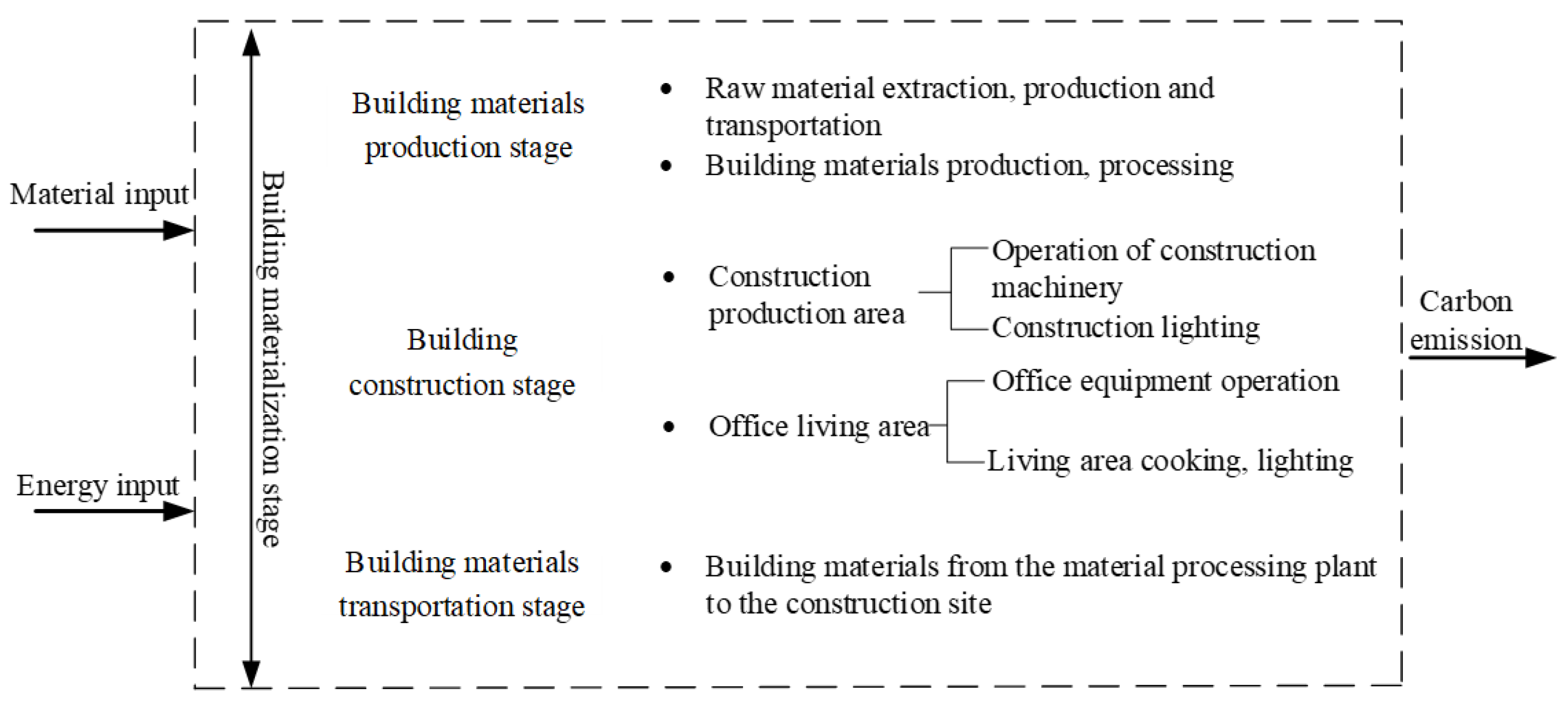

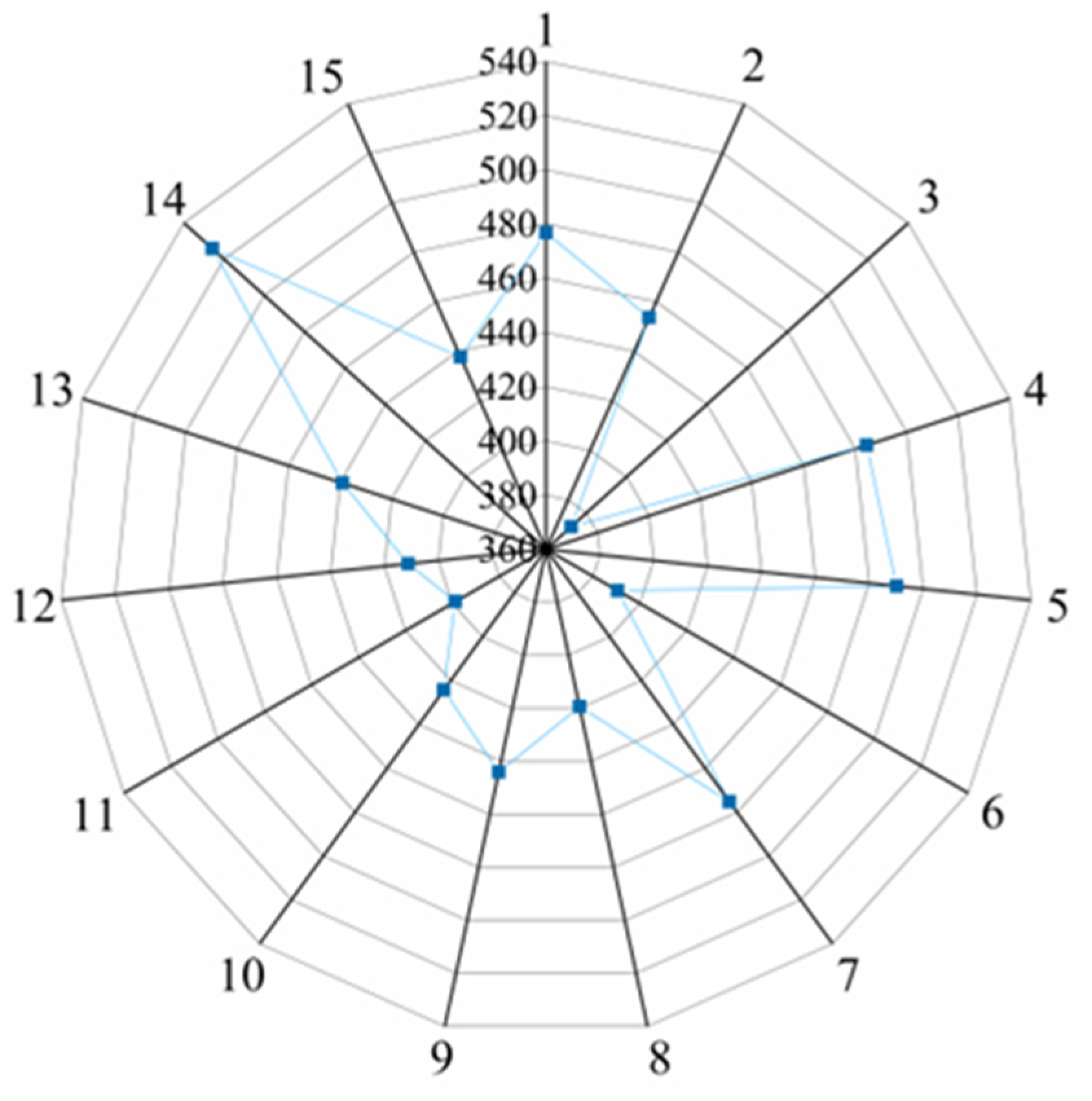
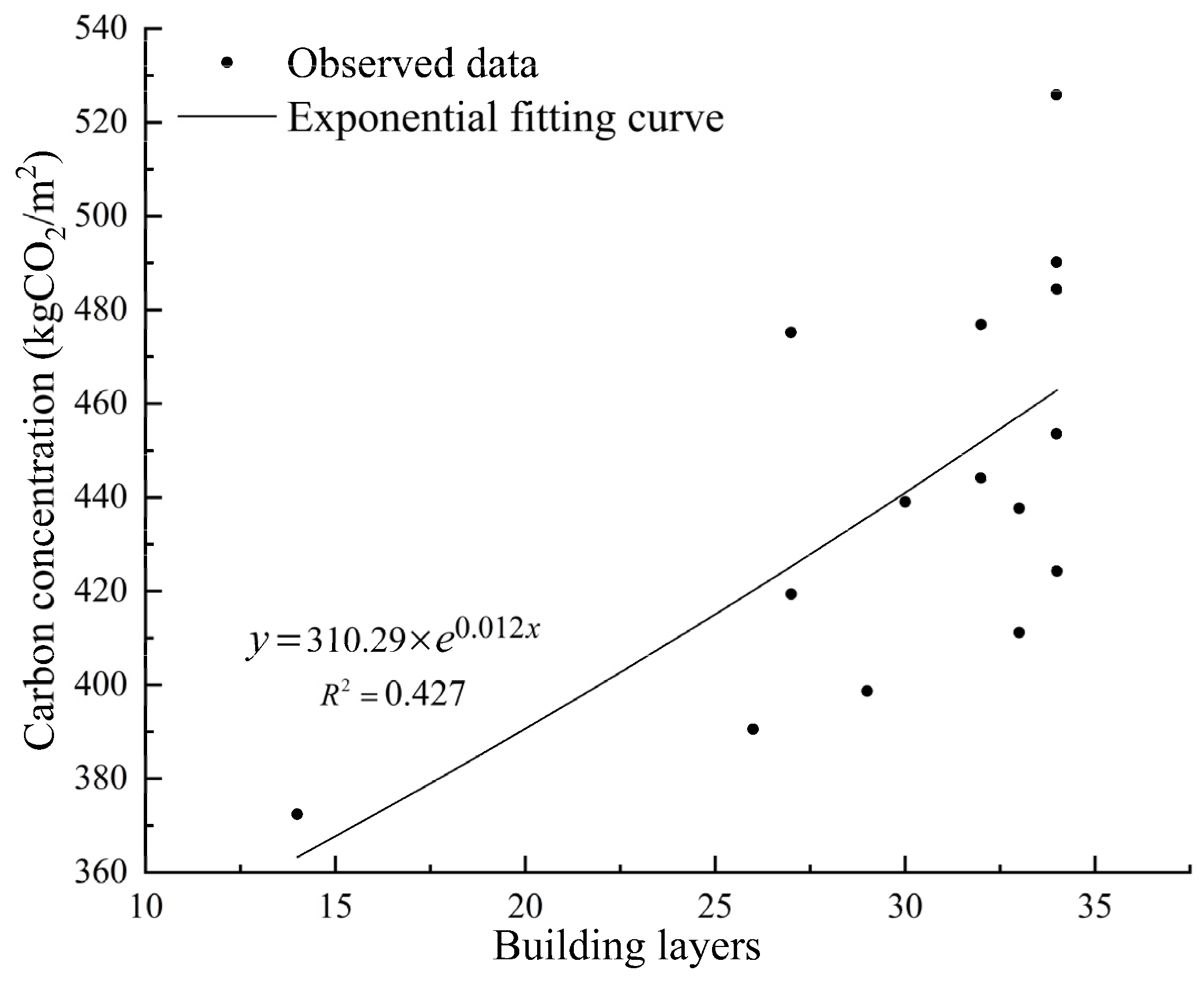
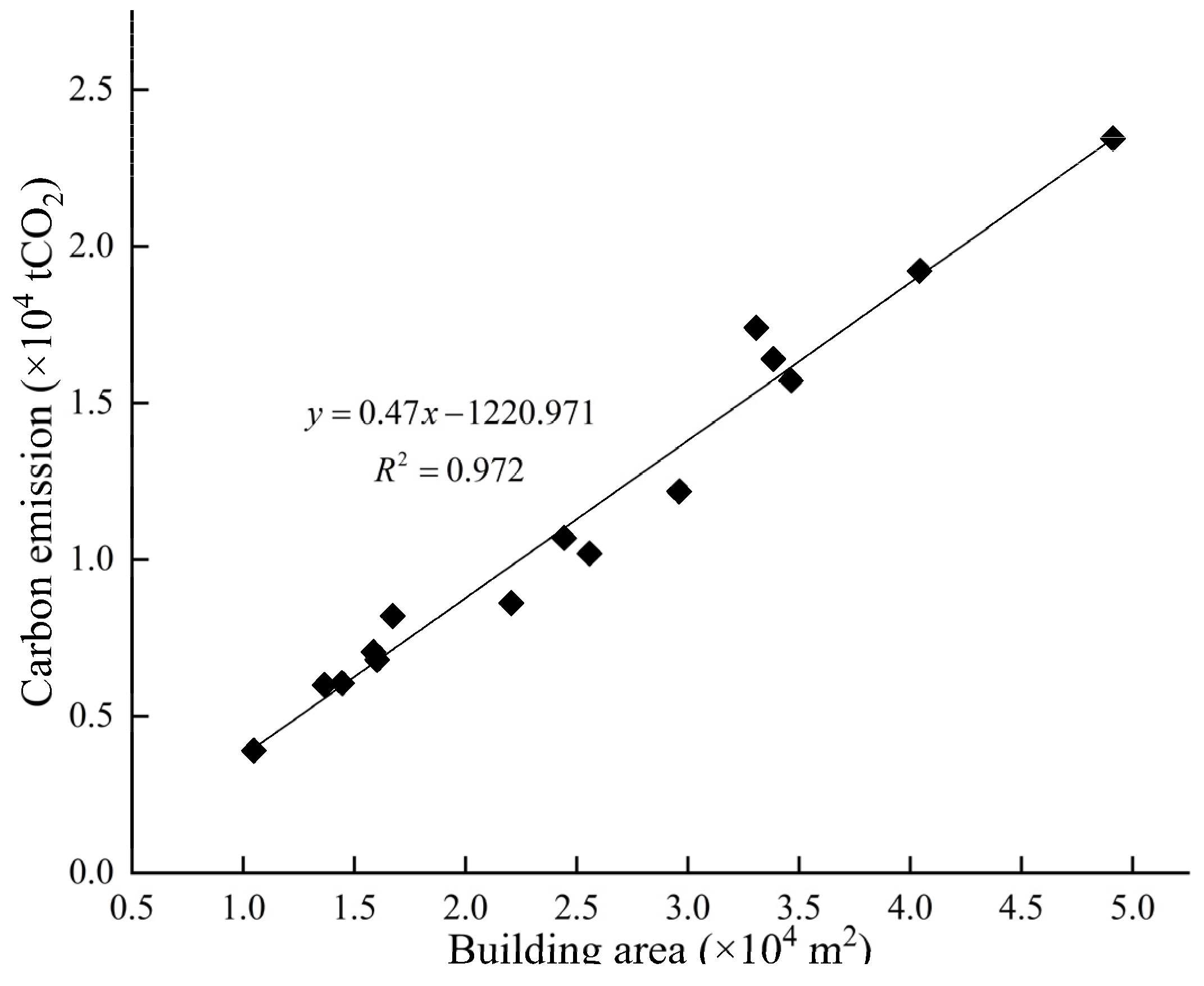
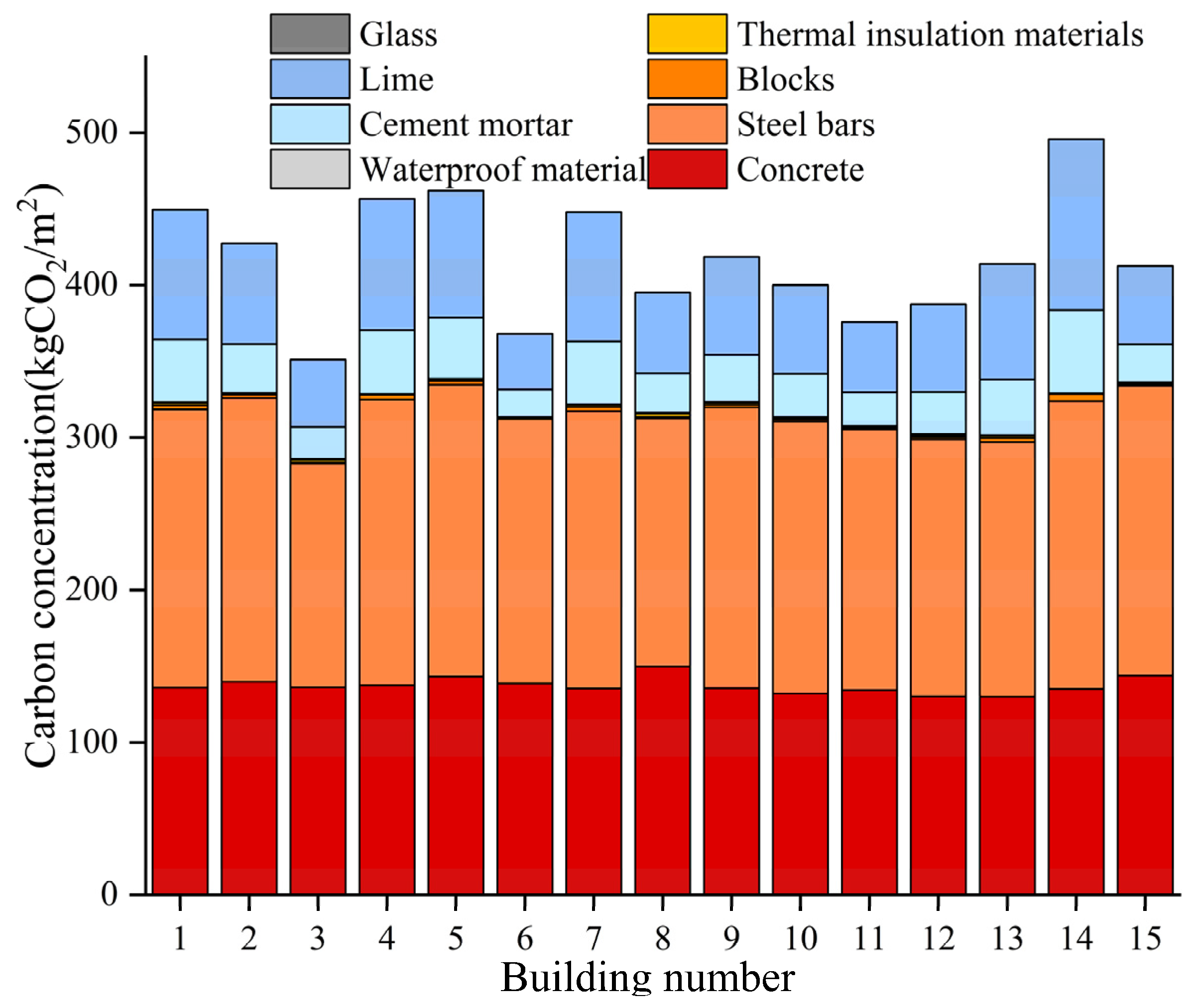
| No. | Stories | Area (m2) | No. | Stories | Area (m2) |
|---|---|---|---|---|---|
| 1 | 32 | 49,157.09 | 9 | 32 | 15,879.81 |
| 2 | 34 | 34,656.93 | 10 | 34 | 16,041.69 |
| 3 | 14 | 10,489.48 | 11 | 29 | 25,568.47 |
| 4 | 34 | 33,866.46 | 12 | 33 | 29,623.18 |
| 5 | 34 | 16,737.94 | 13 | 30 | 13,663.83 |
| 6 | 26 | 22,068.75 | 14 | 34 | 33,094.2 |
| 7 | 27 | 40,448.81 | 15 | 33 | 24,433.97 |
| 8 | 27 | 14,455.32 |
| No. | Material Production | Construction | Material Transportation | Materialization |
|---|---|---|---|---|
| 1 | 449.53 | 18.03 | 9.29 | 476.86 |
| 2 | 427.60 | 17.15 | 8.84 | 453.59 |
| 3 | 351.09 | 14.08 | 7.26 | 372.43 |
| 4 | 456.68 | 18.32 | 9.44 | 484.44 |
| 5 | 462.08 | 18.54 | 9.55 | 490.17 |
| 6 | 368.17 | 14.77 | 7.61 | 390.55 |
| 7 | 447.97 | 17.97 | 9.26 | 475.21 |
| 8 | 395.37 | 15.86 | 8.17 | 419.40 |
| 9 | 418.70 | 16.80 | 8.66 | 444.15 |
| 10 | 399.99 | 16.04 | 8.27 | 424.30 |
| 11 | 375.86 | 15.08 | 7.77 | 398.71 |
| 12 | 387.63 | 15.55 | 8.01 | 411.19 |
| 13 | 413.90 | 16.60 | 8.56 | 439.06 |
| 14 | 495.75 | 19.89 | 10.25 | 525.88 |
| 15 | 412.61 | 16.55 | 8.53 | 437.69 |
| Stage | Mean Value | Confidence Interval (95%) |
|---|---|---|
| Material production | 417.53 | 395.57–439.48 |
| Construction | 16.75 | 15.87–17.63 |
| Material transportation | 8.63 | 8.18–9.09 |
| Materialization | 442.91 | 419.62–466.20 |
| No. | Concrete | Steel Bars | Blocks | Thermal Insulation Materials | Waterproof Materials | Cement Mortar | Lime | Glass |
|---|---|---|---|---|---|---|---|---|
| 1 | 136.01 | 182.40 | 2.99 | 1.42 | 0.31 | 41.26 | 85.11 | 0.016 |
| 2 | 139.89 | 186.19 | 1.92 | 1.18 | 0.30 | 32.03 | 66.08 | 0.010 |
| 3 | 136.06 | 146.93 | 0.67 | 1.71 | 0.40 | 21.33 | 43.99 | 0.004 |
| 4 | 137.51 | 187.39 | 3.05 | 0.59 | 0.34 | 41.72 | 86.06 | 0.016 |
| 5 | 143.32 | 191.24 | 2.88 | 0.85 | 0.36 | 40.29 | 83.11 | 0.015 |
| 6 | 138.65 | 173.65 | 0.42 | 0.68 | 0.38 | 17.76 | 36.63 | 0.002 |
| 7 | 135.54 | 181.77 | 2.98 | 1.42 | 0.31 | 41.12 | 84.82 | 0.016 |
| 8 | 150.00 | 162.58 | 1.19 | 1.85 | 0.71 | 25.80 | 53.22 | 0.006 |
| 9 | 135.68 | 184.03 | 1.81 | 1.33 | 0.54 | 31.11 | 64.18 | 0.010 |
| 10 | 131.99 | 178.61 | 1.46 | 1.27 | 0.46 | 28.14 | 58.05 | 0.008 |
| 11 | 134.35 | 171.16 | 0.78 | 0.95 | 0.43 | 22.26 | 45.92 | 0.004 |
| 12 | 130.18 | 168.72 | 1.44 | 1.32 | 0.48 | 27.91 | 57.57 | 0.008 |
| 13 | 129.97 | 167.27 | 2.46 | 1.41 | 0.49 | 36.66 | 75.63 | 0.013 |
| 14 | 135.18 | 188.60 | 4.84 | 0.29 | 0.38 | 54.34 | 112.09 | 0.026 |
| 15 | 143.87 | 190.06 | 1.23 | 0.97 | 0.29 | 24.87 | 51.31 | 0.007 |
| Scenarios | C1 (kgCO2/m2) | Sensitivity Coefficients |
|---|---|---|
| Scenario 1 | 527.20 | 18.81% |
| Scenario 2 | 447.24 | 0.79% |
| Scenario 3 | 445.56 | 0.41% |
| Material | Reutilization Rate (%) | Material | Reutilization Rate (%) |
|---|---|---|---|
| Steel | 95 | Waste metal | 90 |
| Aluminum | 75 | Glass | 80 |
| Concrete | 60 | Wood | 65 |
| Gravel | 60 | Plastics | 25 |
| Doors and windows | 80 | PVC pipe | 35 |
| Vegetations | Area | Carbon Emission Factors | Carbon Emission |
|---|---|---|---|
| Deciduous trees | 18,364.08 | −13.40 | −738,236.02 |
| Dense shrubs | 16,068.57 | −11.00 | −530,262.81 |
| Tall grasslands | 11,477.55 | −11.50 | −395,975.48 |
| Stages | Carbon Reduction Strategies | Carbon Reduction Amounts | Sensitivity Coefficient |
|---|---|---|---|
| Material production stage | use green building materials | 93.96 | 21.17 |
| improve the recycling rate of building materials | 148.39 | 33.44 | |
| use high-performance building materials | 50.21 | 11.32 | |
| Construction stage | adopt green construction technology | 7.67 | 1.73 |
| increase the green area | 10.88 | 2.45 | |
| Material transportation stage | utilize locally sourced building materials | 2.24 | 0.50 |
| choose appropriate transportation machinery | 0.05 | 0.01 |
Disclaimer/Publisher’s Note: The statements, opinions and data contained in all publications are solely those of the individual author(s) and contributor(s) and not of MDPI and/or the editor(s). MDPI and/or the editor(s) disclaim responsibility for any injury to people or property resulting from any ideas, methods, instructions or products referred to in the content. |
© 2023 by the authors. Licensee MDPI, Basel, Switzerland. This article is an open access article distributed under the terms and conditions of the Creative Commons Attribution (CC BY) license (https://creativecommons.org/licenses/by/4.0/).
Share and Cite
Cheng, S.; Zhou, X.; Zhou, H. Study on Carbon Emission Measurement in Building Materialization Stage. Sustainability 2023, 15, 5717. https://doi.org/10.3390/su15075717
Cheng S, Zhou X, Zhou H. Study on Carbon Emission Measurement in Building Materialization Stage. Sustainability. 2023; 15(7):5717. https://doi.org/10.3390/su15075717
Chicago/Turabian StyleCheng, Shengdong, Xin Zhou, and Huan Zhou. 2023. "Study on Carbon Emission Measurement in Building Materialization Stage" Sustainability 15, no. 7: 5717. https://doi.org/10.3390/su15075717
APA StyleCheng, S., Zhou, X., & Zhou, H. (2023). Study on Carbon Emission Measurement in Building Materialization Stage. Sustainability, 15(7), 5717. https://doi.org/10.3390/su15075717





